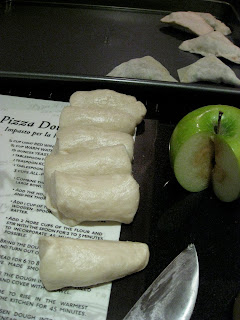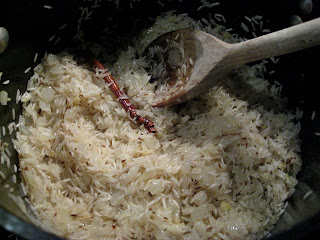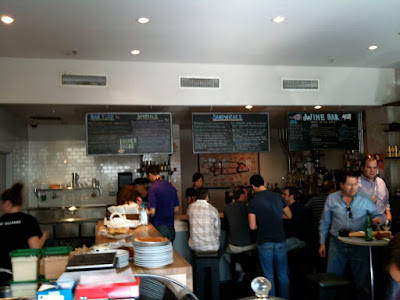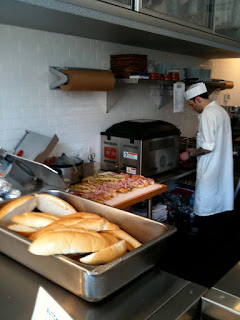We were fourtunate enough to have the privilege to attend (a couple weeks ago, I've been busy) the first of hopefully many ‘Farm-Maker’ dinners at Tom Colicchio's excellent
Craft restaurant. I'll let them describe it in their words from the notice I saw:
At Craft’s inaugural ‘Farm-Maker’ dinner, we celebrate the work of Rick Bishop of Mountain Sweet Berry Farm and Hudson Valley Foie Gras.
Chef Tom Colicchio along with chef de cuisine, James Tracey and pastry chef, Stephen Collucci will prepare a five-course menu highlighting Rick Bishop’s spectacular autumn produce as well as the ducks of Hudson Valley.
Please join us for dinner and discussion about local food and farming on this special November night at Craft.
The night was special indeed. It was all the more special because our party of four was seated at the six top with the none other than the farmer's themselves, Rick and Nicole Bishop. (This was just luck as far as I know, perhaps we were the only group of 4 or the other 3 tables had different size groups. Or maybe I booked first, I did respond pretty quickly to the invite.)
Here is an interview with Rick, and
here is a nice video about his farm and green markets in general. And here is our menu from the night (click to enlarge):
You'll note that we were promised a five course dinner, but they ended up giving us eight courses. What bastards. Every dish used at least one type of produce from the farms, oftentimes several. They were all great, and some obscure crops I've never had before. As good as the food was, talking with Rick and Nicole about how it was grown was at least as much a part of the great night.
Here are some random observations from some of the dishes I recall, mainly touching about stuff we learned about the produce from the farm.
For the first course, this was the first time I was aware of trying
lovage, at least in such an obvious fashion. This despite the fact I have it growing in our herb garden; I just didn't know what to do with it. The main thing I took from this course is that it's good and I need to start finding ways to use it.
The second course had two more types of produce from the farm I'd never tried, and these two I had never even heard of.
Sucrine is a sweet baby type of romaine, and
nepitella is a minty Italian herb with very strong flavor so should be used sparingly. Here they used it in the marinade before searing the fish, and then added a small amount after it was plated. The nepitella was strong indeed, but all the greens added a nice flavor and complexity to the dish.
The third dish was delicious all around, but the star of the show were the fresh Flageolet beans. Colicchio told us how excited he got about the fresh beans and how big a difference fresh vs dried makes for beans, comparing it to fresh vs dried herbs. All I have to say is I agree. Both the flavor and the texture of these fresh beans were a world apart from their dried brethren.
The sturgeon for the fourth course may have been our favorite, which is surprising because we typically like both meat and raw fish more than cooked fish. This sturgeon was an exception. (It probably doesn't hurt that not only was it wrapped in porky speck but that sturgeon it a very meaty fish, but we loved it for more reasons than that.) The beets were from Rick's farm, and at first he had been disappointed that due to weather conditions they had turned out to be pretty tiny, but in fact all the sweet earthy beetness was all packed into a tiny package. They were like tiny candies, quite successfully playing off the richness of the sturgeon.
I hope to have more to say about the sturgeon later, because I think our plan is to try to learn how to cook it when we do our private cooking lesson with Colicchio sometime next year, which we won at
auction at
City Harvest's Bid Against Hunger event we attended in October. But that will be months from now. I'll keep you posted.
I'll skip the next two for brevity's sake and move onto and end with a discussion of the Porchetta, because it had the most interesting produce in the spigarello and the polenta.
Spigarello is a variety of broccoli, but you would not recognize it by looking, as the florets are small and its leafy greens are the part you use. They have an earthy richness and are apparently quite prolific in their growing habits. You are supposed to be able to cut off a serving quite often during the growing season, so I hope to try to find some to grow next year. They remind me of a tender kale (which
I love), mildly reminiscent of broccoli flavor.
This blog's advice is: if you see it, BUY IT! The polenta was also
special, I'll let Colicchio tell you about it in
his own words about his road trip from Atlanta:
Glenn's newest project is another near extinct breed of corn called Perla Bianca, an ear of which Ben Dubbard managed to wrangle from an old farmer during a trip to Italy last fall. Now, using that ear for seed stock, Glenn is working tirelessly to cultivate it in South Carolina. Some of the first locally grown Perla Bianca kernels made it back to the Anson Mills office just a few days before our visit, and Glenn milled some into polenta — one whiff of the freshly milled corn and it's obvious why Glenn's fighting for it. Its floral, milky scent and sweet taste are unlike anything I've known.
He told us at the dinner that he bought the whole crop, all 30 pounds of it, and that it will be hard to make it last long at all.
Anyway, it was a fun, educational, and delicious night. I look forward to the next one the chef said would probably be in the spring.






















































